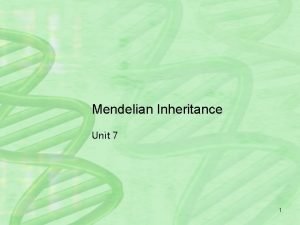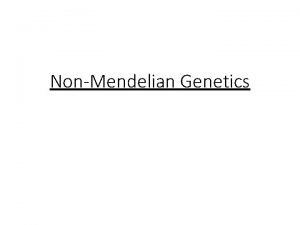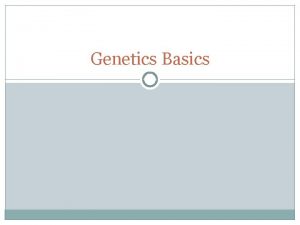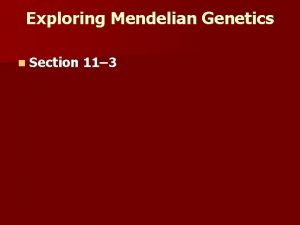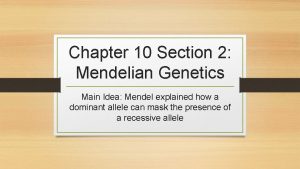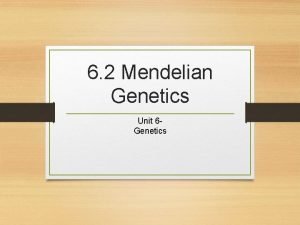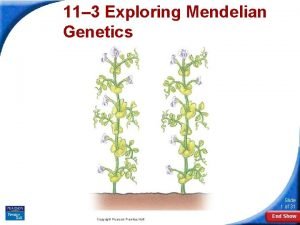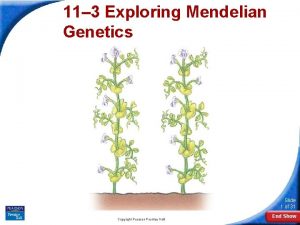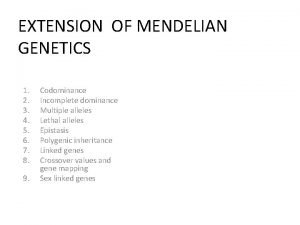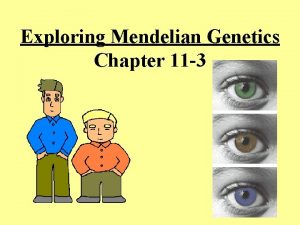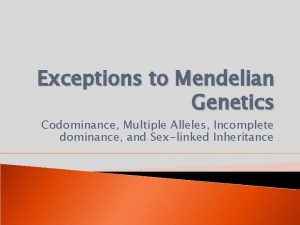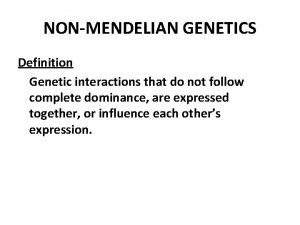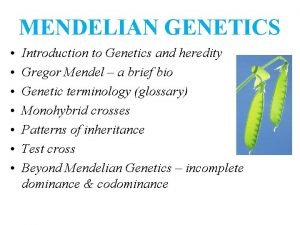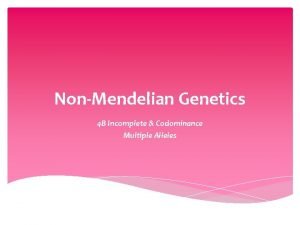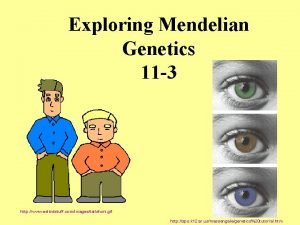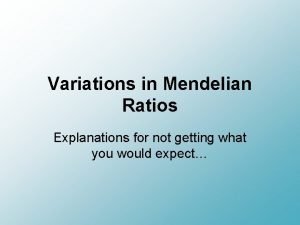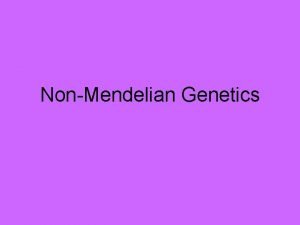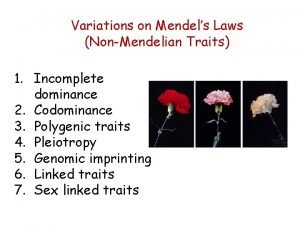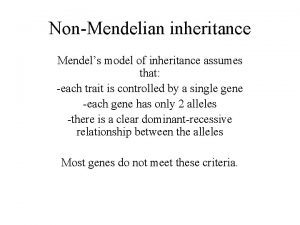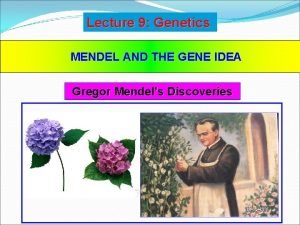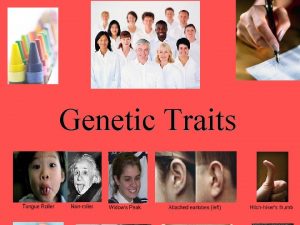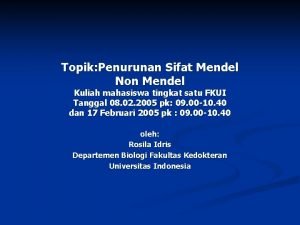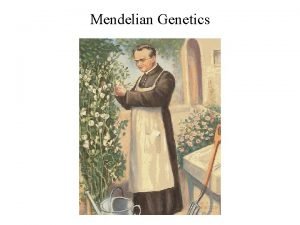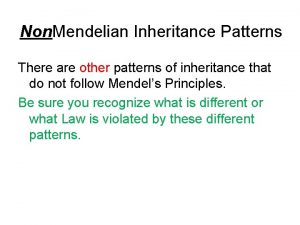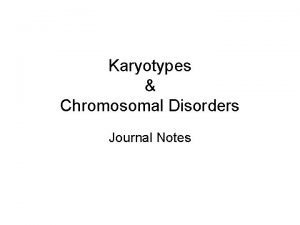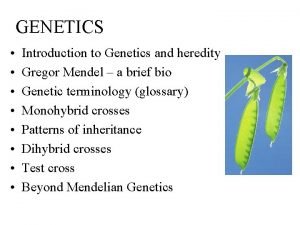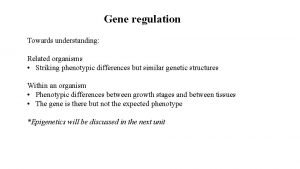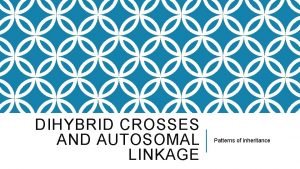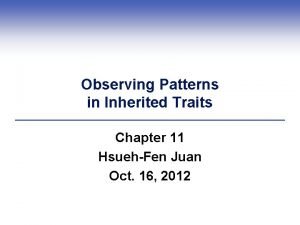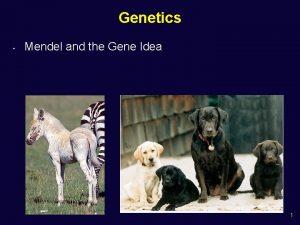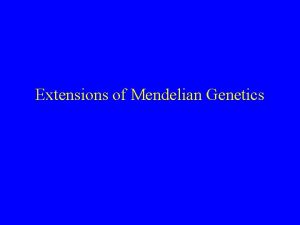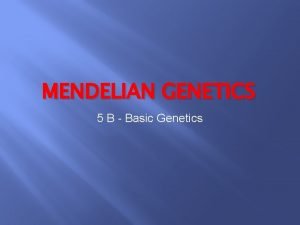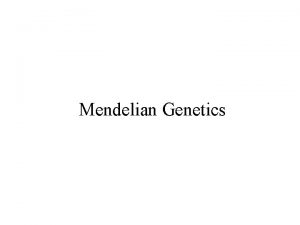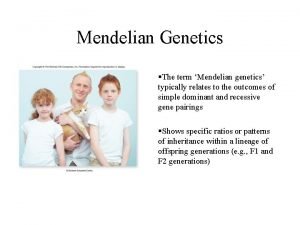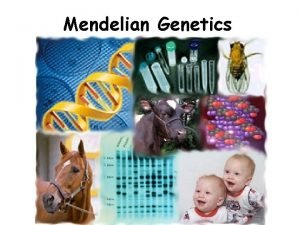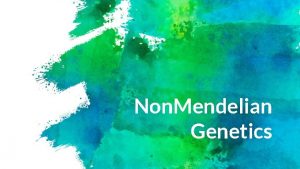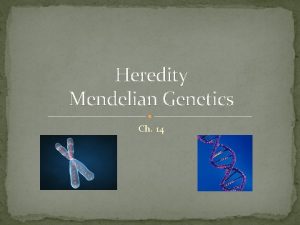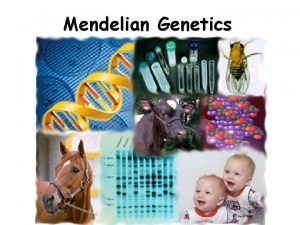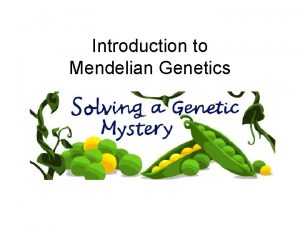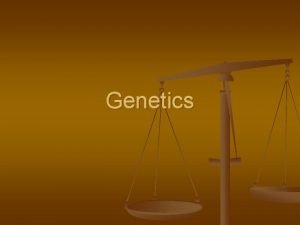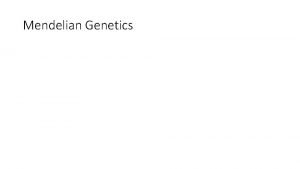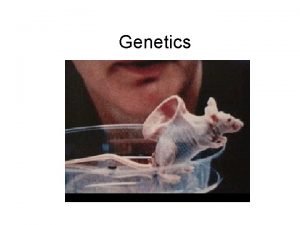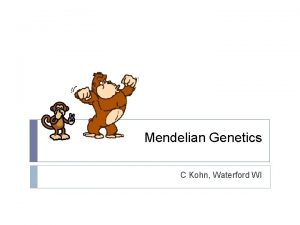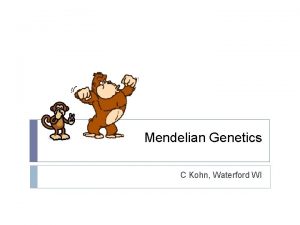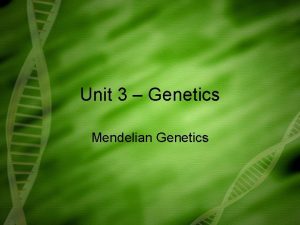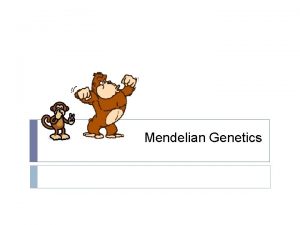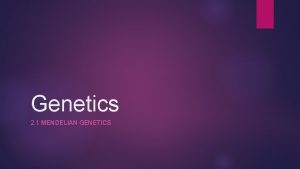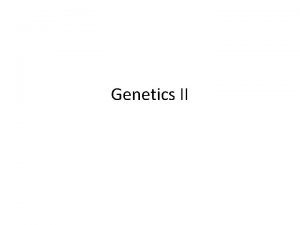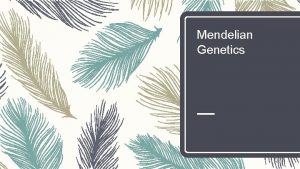Mendelian Genetics These are a list of words

















































- Slides: 49

Mendelian Genetics

These are a list of words used within the collegeboard questions. It would be helpful for you to familiarize yourself with them. As you go through this slides presentation, you will come across words that are a different color and underlined. When you click on the word, it will take you to a picture of the definition of that word. For example, the word progeny. (Click on progeny, lol) © Mary Neimeyer Important Vocabulary 1. 2. 3. 4. 5. 6. 7. 8. 9. 10. 11. 12. 13. 14. 15. Crossed Locus/loci Alleles Wildtype Inheritance pattern Affected individuals Mutant allele Single copy of allele (Heterozygous) Mated Autosomal recessive P, F 1, F 2 Hybrid True Breeding Interbreed Displayed (shows/has) 16. Carrier 17. Self-pollinated 18. Testcrossed 19. Segregate 20. Homologous chromosomes 21. Huntington’s Disease 22. Cystic Fibrosis 23. Law of independent assortment 24. Sickle Cell 25. Incidence (likelihood of happening) 26. “Distribution of traits” numbers or ratios 27. Progeny

Linked below are Youtube Videos of the Lecture Portion of this chapter © Mary Neimeyer

The following slides contain practice problems. For each problem, the answers/solution will be on the next slide. There will also be a video explanation in case the red ink isn’t enough. © Mary Neimeyer

Mendel crossed true breeding tall pea plants with true breeding short pea plants to produce an F 1 generation that were all tall. The F 1 hybrids were allowed to self-fertilize. The F 2 progeny display the following phenotypes: Tall: 787 Short 227 a. What does true breeding mean? B. What is the genotype of a hybrid? c. What does F 1 refer to? d. What is the cross described here “The F 1 hybrids were allowed to self-fertilize”? e. When looking at the data presented, what ratio is it closest to? f. Which is the dominant phenotype, Tall or short? How do you know? © Mary Neimeyer 18 sec video on self pollination/ self-fertilize

Click on this yellow box for video solution or image below for youtube © Mary Neimeyer Mendel crossed true breeding tall pea plants with true breeding short pea plants to produce an F 1 generation that were all tall. The F 1 hybrids were allowed to self-fertilize. The F 2 progeny display the following phenotypes: Tall: 787 Short 227 a. What does true breeding mean? Homozygous for a trait. When the plant self-fertilizes, it breeds true. Ex. A purple plant that self-fertilizes, will only ever produce purple offspring, never any white because it only has dominant alleles) B. What is the genotype of a hybrid? Tt c. What does F 1 refer to? The offspring of the two parents d. What is the cross described here “The F 1 hybrids were allowed to selffertilize”? Tt x Tt e. When looking at the data presented, what ratio is it closest to? 3: 1 f. Which is the dominant phenotype, Tall or short? How do you know? Tall because the F 1 are all tall.

Dimples are a single gene trait thought to be inherited as autosomal _____. When a true breeding dimpled individual is crossed with a true breeding nondimpled individual, all of the F 1 offspring display dimples. Then the F 1 offspring are testcrossed, there are both dimpled and non-dimpled offspring in the F 2. Parental Cross Phenotypes of F 1 Offspring Dimples x No Dimples Phenotypes of Testcross Offspring (numbers of individuals) Dimples (8) No Dimples (6) a. What are the genotypes of the parents? ** Answers are on next slide** © Mary Neimeyer a. Is the pattern or mode of inheritance for the dimples trait autosomal dominant or autosomal recessive? How do you know?

Click on this yellow box for video solution or image below for youtube D D d Dd Dd © Mary Neimeyer Dimples are a single gene trait thought to be inherited as autosomal _____. When a true breeding dimpled individual is crossed with a true breeding nondimpled individual, all of the F 1 offspring display dimples. Then the F 1 offspring are testcrossed, there are both dimpled and non-dimpled offspring in the F 2. Parental Cross Phenotypes of F 1 Offspring Dimples x No Dimples Phenotypes of Testcross Offspring (numbers of individuals) Dimples (8) No Dimples (6) a. What are the genotypes of the parents? Dimples x No Dimples DD x dd (The question states they are both true breeding so you know they are homozyg for their traits) a. Is the pattern or mode of inheritance for the dimples trait autosomal dominant o autosomal recessive? How do you know? Autosomal Dominant because the F 1 a have the dominant phenotype.

*** Using the pattern of inheritance from the previous slide *** If a person true breeding for dimples is crossed with a hybrid, what proportion of their offspring will display the recessive phenotype? © Mary Neimeyer

*** Using the pattern of inheritance from the previous slide *** If a person true breeding for dimples is crossed with a hybrid, what proportion of their offspring will display the recessive phenotype? D = Dimples d = No dimples True Breeding Dimples = DD Hybrid = Dd DD x Dd 0% © Mary Neimeyer D DD DD d Dd Dd Click on this yellow box for video solution or image below for youtube

If a person is a hybrid for the dimples phenotype, what kind of gametes will they produce? © Mary Neimeyer

If a person is a hybrid for the dimples phenotype, what kind of gametes will they produce? Due to Mendel’s law of segregation, the diploid Dd alleles separate into haploid D or d gametes. Click on this yellow box for video solution or image below for youtube © Mary Neimeyer D D d d

Parental Cross Phenotypes of F 1 Offspring Taster x Taster Phenotypes of Testcross Offspring (numbers of individuals) Taster (7) Non Taster (9) a. Which is inherited as dominant - Taster or nontaster? b. What are the possible genotypes of the parents? a. What is the genotype of the F 1 offspring that is used in the testcross? ** Answers are on next slide** © Mary Neimeyer a. What is the mode of inheritance/pattern of inheritance for the ability to taste?

Parental Cross Phenotypes of F 1 Offspring Taster x Taster Box 1 Click on this yellow box for video solution or image below for youtube Box 2 Taster (7) Non Taster (9) Box 3 a. Which is inherited as dominant - Taster or nontaster? Taster is the dominant allele. We can see this because later in the F 2 the nontaster phenotype appears. That means that it has been “hidden” as a recessive allele. a. What are the possible genotypes of the parents? The parents can be TT or Tt and display the taster phenotype. As we look at the data, we see that some of the F 2 (box 3) are tt, therefore the Taster parent in box 2 carries a recessive, t allele. a. What is the genotype of the F 1 T t F 1 taster parent offspring that is used in the testcross? Testcross Parent © Mary Neimeyer Phenotypes of Testcross Offspring (numbers of individuals) t Tt tt tt a. What is the mode of inheritance/pattern of inheritance for the ability to taste? (Autosomal) Dominant. The nontaster offspring is your clue.

Scientists were studying Trichechus latirostris (the Florida manatee) and their inheritance pattern of a single gene trait for a hairy back vs a nonhairy back. The scientists mated a hairy T. latirostris from a Northern population with a non-hairy T. latirostris from an Eastern population. The resulting F 1 hybrids all displayed a hairy phenotype. a. What does “single gene trait” mean? a. What are the genotypes of the parents? The F 1 hybrids interbreed producing an F 2 generation that had 20 hairy manatees and 6 non-hairy manatees. a. What ratio is 20 to 6 closest to? a. Which is the dominant allele? Recessive allele? How do you know? © Mary Neimeyer

Scientists were studying Trichechus latirostris (the Florida manatee) and their inheritance pattern of a single gene trait for a hairy back vs a nonhairy back. The scientists mated a hairy T. latirostris from a Northern population with a non-hairy T. latirostris from an Eastern population. The resulting F 1 hybrids all displayed a hairy phenotype. Click on this yellow box for video solution or image below for youtube © Mary Neimeyer a. What does “single gene trait” mean? It is a trait determined by the proteins produced at a single locus on a chromosome. b. What are the genotypes of the parents? HH x hh (we know the parents were true breeding because the F 1 all have the same phenotype) The F 1 hybrids interbreed producing an F 2 generation that had 20 hairy manatees and 6 non-hairy manatees. a. What ratio is 20 to 6 closest to? 3: 1 a. Which is the dominant allele? Recessive allele? How do you know? Hairy is dominant, non-hairy is recessive because the F 1 all displayed a hairy phenotype. Additionaly, the ratio showed 75% as hairy.

On a hike in the Eastern Sierras mountain range, you find an endangered pika, Ochotona Minor. The pika displays the wild-type phenotype of brown fur. You are unsure about the pika’s genotype, so you perform a testcross. 5 wild-type and 4 albino pika are produced in the F 1 generation. Write the cross of the parental generation. What is the genotype of the wild-type parent? © Mary Neimeyer

On a hike in the Eastern Sierras mountain range, you find an endangered pika, Ochotona Minor. The pika displays the wild-type phenotype of brown fur. You are unsure about the pika’s genotype, so you perform a testcross. 5 wild-type and 4 albino pika are produced in the F 1 generation. Write the cross of the parental generation. What is the genotype of the wild -type parent? Parental Cross: B? x bb (Because the question states that they performed a testcross, it implies that the wild-type is dominant. Because you don’t know if the pika is BB or Bb, that is why there is a ? in the place of the second allele. Because the F 1 produce both wild-type and albino, we know that the wildtype parent is heterozygous (hybrid). © Mary Neimeyer Click on this yellow box for video solution or image below for youtube

A true-breeding pika is crossed with an albino pika. The F 1 all display the wild-type phenotype. The F 1 are allowed to interbreed. The F 2 offspring are produced in a 3: 1 ratio. What is the mode of inheritance for the albino allele? The wild-type allele? Support your answer. © Mary Neimeyer

A true-breeding pika is crossed with an albino pika. The F 1 all display the wild-type phenotype. The F 1 are allowed to interbreed. The F 2 offspring are produced in a 3: 1 ratio. What is the mode of inheritance for the albino allele? The wild-type allele? Support your answer. The wild-type is inherited as autosomal dominant because the F 1 are all wild-type. The albino phenotype is inherited as autosomal recessive because there are no albino offspring in the F 1 even though there was an albino parent. We see the albino phenotype again in the F 2 as 25% of the offspring. Click on this yellow box for video solution or image below for youtube © Mary Neimeyer

The GES 5 R 32 gene encodes a receptor protein that influences the ability to smell the flower scent emitted by roses. The gene has two alleles: a dominant, wild-type allele that enables an individual (smeller) to smell the roses, and a recessive, mutant allele that interferes with the ability of an individual (non-smeller) to smell the roses. A true breeding smeller is mated with a true breeding non-smeller. F 1 is testrossed. What is the phenotypic ratio of the F 2 progeny? © Mary Neimeyer

The GES 5 R 32 gene encodes a receptor protein that influences the ability to smell the flower scent emitted by roses. The gene has two alleles: a dominant, wild-type allele that enables an individual (smeller) to smell the roses, and a recessive, mutant allele that interferes with the ability of an individual (non-smeller) to smell the roses. A true breeding smeller is mated with a true breeding non-smeller. F 1 is testrossed. What is the phenotypic ratio of the F 2 progeny? Click on this yellow box for video solution or image below for youtube © Mary Neimeyer Phenotypic Ratio 1: 1

Shape of tail feathers in a certain species of hummingbirds is influenced by one gene with two alleles: a dominant allele that results in a fan shape and a recessive allele that results in no fans at the end. A fan-tailed female from a true breeding population is mated with a non-fan tail male. What is the probability of an offspring being born with non-fan tails? Explain. © Mary Neimeyer

Shape of tail feathers in a certain species of hummingbirds is influenced by one gene with two alleles: a dominant allele that results in a fan shape and a recessive allele that results in no fans at the end. A fan-tailed female from a true breeding population is mated with a non-fan tail male. What is the probability of an offspring being born with non-fan tails? Explain. Click on this yellow box for video solution or image below for youtube 0% © Mary Neimeyer

Here are my results from 23 andme for my muscle composition. My son, Max, does not produce the alpha-actin-3 protein. What is his genotype and phenotype? What is my husband’s genotype and phenotype? © Mary Neimeyer

Here are my results from 23 andme for my muscle composition. My son, Max, does not produce the alpha-actin-3 protein. What is his genotype and phenotype? What is my husband’s genotype and phenotype? Max - TT Husband, CT or TT (Truthfully, he’s CT) © Mary Neimeyer

Freckles is reportedly controlled by a single gene with two alleles. The dominant allele results in the presence of freckles, while the recessive allele results the absence of freckles. Two individuals both heterozygous for freckles produce many children over the course of their lives together. Predict the frequency of children with no freckles from these two parents. © Mary Neimeyer

Freckles is reportedly controlled by a single gene with two alleles. The dominant allele results in the presence of freckles, while the recessive allele results the absence of freckles. Two individuals both heterozygous for freckles produce many children over the course of their lives together. Predict the frequency of children with no freckles from these two parents. Click on this yellow box for video solution or image below for youtube 25% © Mary Neimeyer

In a pika, there are three unlinked genes A, B, C, all at their own loci. If a female pika is heterozygous for each of these genes, what is the likelihood of her gamete being abc? © Mary Neimeyer

In a pika, there are three unlinked genes A, B, C, all at their own loci. If a female pika is heterozygous for each of these genes, what is the likelihood of her gamete being abc? Click on this yellow box for video solution or image below for youtube © Mary Neimeyer 1/8

In a pika, there are four unlinked genes A, B, C, D all at their own loci. If a female pika is heterozygous for each of these genes, what is the likelihood of her gamete being Abc. D? © Mary Neimeyer

In a pika, there are four unlinked genes A, B, C, D all at their own loci. If a female pika is heterozygous for each of these genes, what is the likelihood of her gamete being Abc. D? Click on this yellow box for video solution or image below for youtube © Mary Neimeyer 1/16

Cystic Fibrosis is inherited an autosomal recessive disease. If a carrier is crossed with a affected individual, and they have two children, what is the probability that both children have cystic fibrosis? If two carriers are crossed and have two children, what is the probability that both children will be affected? If two carriers are crossed and have two children, what is the probability that neither child will be affected? © Mary Neimeyer

Click on this yellow box for video solution or image below for youtube Cystic Fibrosis is inherited an autosomal recessive disease. If a carrier is crossed with a affected individual, and they have two children, what is the probability that both children have cystic fibrosis? 1/4 If two carriers are crossed and have two children, what is the probability that both children will be affected? 1/16 If two carriers are crossed and have two children, what is the probability that neither child will be affected? 9/16 © Mary Neimeyer

Time to take it up a notch and begin to work on Dihybrid crosses! Amoeba Sisters: (cross of TWO traits) Dihybrid and Two trait crosses © Mary Neimeyer Bozeman: A beginners guide to Punnett Squares

Parental Cross Wild-type x albino Phenotype of the F 1 Phenotypes of Testcross offspring Wild-type 17 Albino 19 a. Write out the cross (the genotype) of the parental generation. a. Which phenotype is dominant? How do you know? a. Write out the testcross of the F 1 individuals. Why were the results in a 1: 1 phenotypic ratio? © Mary Neimeyer

Parental Cross Wild-type x albino Phenotype of the F 1 Phenotypes of Testcross offspring Wild-type 17 Albino 19 a. Write out the cross (the genotype) of the parental generation. AA x aa a. Which phenotype is dominant? How do you know? Wildtype a. Write out the testcross of the F 1 individuals. Why were the results in a 1: 1 phenotypic ratio? © Mary Neimeyer Because the cross was between a Aa x

Parental Cross Phenotype of the F 1 Phenotypes of Testcross offspring Wild-type x albino Wild-type 17 Albino 19 Brown Eyes x Red Eyes Brown Eyes 20 Red Eyes 18 a. Based on the data for brown and red eye phenotypes, what is the pattern of inheritance for brown eyes? How do you know? © Mary Neimeyer

Parental Cross Phenotype of the F 1 Phenotypes of Testcross offspring Wild-type x albino Wild-type 17 Albino 19 Brown Eyes x Red Eyes Brown Eyes 20 Red Eyes 18 a. Based on the data for brown and red eye phenotypes, what is the pattern of inheritance for brown eyes? How do you know? Autosomal dominant © Mary Neimeyer

Parental Cross Wild-type x albino Box 1 Brown Eyes x Red Eyes Box 4 Wild-type, Brown Eyes x Albino, Red Eyes Box 7 Phenotype of the F 1 Phenotypes of Testcross offspring Wild-type Box 2 Brown Eyes Box 5 Wild-type, Brown eyes Box 8 Wild-type 17 Box 3 Brown Eyes 20 Box 6 Wildtype, Brown 9 Albino, Brown 10 Albino 19 Red Eyes 18 Wildtype, Red 11 Albino, Red 8 Box 9 a. Explain why there are no red eyed offspring in boxes 5 and 8. b. Set up and complete the cross that resulted in the data found in box 9. © Mary Neimeyer

Parental Cross Wild-type x albino Box 1 Brown Eyes x Red Eyes Click on this yellow Box 4 box for video solution Wild-type, Brown Eyes or image below for x youtube Albino, Red Eyes Box 7 Phenotype of the F 1 Phenotypes of Testcross offspring Wild-type Box 2 Brown Eyes Box 5 Wild-type, Brown eyes Box 8 Wild-type 17 Box 3 Brown Eyes 20 Box 6 Wildtype, Brown 9 Albino, Brown 10 Albino 19 Red Eyes 18 Wildtype, Red 11 Albino, Red 8 Box 9 a. Explain why there are no red eyed offspring in boxes 5 and 8. Because red eyes is a recessive allele and you need to copies to display that phenotype. b. Set up and complete the cross that resulted in the data found in box 9. Shown/solved in the video © Mary Neimeyer

B = Dark Brown Fur b = Spotted Fur © Mary Neimeyer E = Floppy Ears e = Pointed Ears Heterozygous Dark Brown dog with floppy ears, is crossed with a heterozygous Dark Brown dog with floppy ears. What are the expected phenotypic ratios of the offspring?

B = Dark Brown Fur b = Spotted Fur E = Floppy. Click Earson this Heterozygous Dark Brown dog with floppy ears, is crossed yellow e = Pointed box. Ears for video solution with a heterozygous Dark Brown dog with floppy ears. What or image below are thefor expected phenotypic ratios of the offspring? youtube 9: 3: 3: 1 © Mary Neimeyer Bb. Ee x Bb. Ee

In Drosophila melanogaster the allele for wild type brown body color (B) is dominant to the recessive allele for Ebony body color (b). The allele for wild-type wing shape (G) is dominant to the recessive allele for curly wing phenotype (g). A female fly heterozygous for both traits is crossed with a male fly with ebony body color and curled wings. What phenotypes are possible in their offspring? Complete the cross described above. © Mary Neimeyer

In Drosophila melanogaster the allele for wild type brown body color (B) is dominant to the recessive allele for Ebony body color (b). The allele for wild-type wing shape (G) is dominant to the recessive allele for curly wing phenotype (g). A female fly heterozygous for both traits is crossed with a male fly with ebony body color and curled wings. What phenotypes are possible in their offspring? Complete the cross described above. Brown, Wild type wings Click on this yellow box for video solution or image below for youtube Brown, curled wings b. G bg bg Bb. Gg Bbgg bb. Gg bbgg bg 1: 1: 1: 1 All phenotypes are bg 25% likely Bb. Gg Bbgg bb. Gg bbgg Ebony, Wild type Ebony, curled © Mary Neimeyer Bb. Gg x bbgg BG Bg

Mrs. Neimeyer is heterozygous for the factor 5 gene which is inherited as autosomal dominant and results in the development of blood clots. Mr. Neimeyer is not affected with this blood clotting disorder. Unfortunately, the are both hybrids for late onset alzheimer’s. What is the probability of them producing a child that is not at risk for developing blood clots, but will develop late onset alzheimer’s? (For this example, let's assume that alzheimer’s is autosomal recessive). © Mary Neimeyer

Mrs. Neimeyer is heterozygous for the factor 5 gene which is inherited as autosomal dominant and results in the development of blood clots. Mr. Neimeyer is not affected with this blood clotting disorder. Unfortunately, the are both hybrids for late onset alzheimer’s. What is the probability of them producing a child that is not at risk for developing blood clots, but will develop late onset alzheimer’s? (For this example, let's assume that alzheimer’s is autosomal recessive). Click on this yellow box for video solution or image below for youtube © Mary Neimeyer 1/8

Hereditary hemochromatosis is a genetic condition characterized by absorption of too much dietary iron. This may lead to iron overload, which can cause damage to the joints and certain organs, such as the liver, skin, heart, and pancreas. Age-related macular degeneration (AMD) is the most common cause of irreversible vision loss among older adults. The disease results in damage to the central part of the retina (the macula), impairing vision needed for reading, driving, or even recognizing faces. Both of these conditions are inherited as autosomal recessive. Truthfully, Mr. and Mrs. Neimeyer are both hybrids for both of these traits. a. What is the probability that their children will be born not affected by either disorder? b. What is the probability that their children will be born affected by both disorders? © Mary Neimeyer

Hereditary hemochromatosis is a genetic condition characterized by absorption of too much dietary iron. This may lead to iron overload, which can cause damage to the joints and certain organs, such as the liver, skin, heart, and pancreas. Age-related macular degeneration (AMD) is the most common cause of irreversible vision loss among older adults. The disease results in damage to the central part of the retina (the macula), impairing vision needed for reading, driving, or even recognizing faces. Both of these conditions are inherited as autosomal recessive. Truthfully, Mr. and Mrs. Neimeyer are both hybrids for both of these traits. a. What is the probability that their children will be born not affected by either disorder? 9/16 b. What is the probability that their children will be born affected by both disorders? 1/16 Click on this yellow box for video solution or image below for youtube © Mary Neimeyer
 Mikael ferm
Mikael ferm Family resemblance test
Family resemblance test Codominance example
Codominance example Section 11-5 linkage and gene maps answer key
Section 11-5 linkage and gene maps answer key Heterozygous b blood type
Heterozygous b blood type Chapter 7 extending mendelian genetics answer key
Chapter 7 extending mendelian genetics answer key Section 11-3 exploring mendelian genetics
Section 11-3 exploring mendelian genetics Chapter 10 section 2: mendelian genetics
Chapter 10 section 2: mendelian genetics Mendel was a
Mendel was a Section 11-3 exploring mendelian genetics answers
Section 11-3 exploring mendelian genetics answers 11-3 exploring mendelian genetics
11-3 exploring mendelian genetics Karyotype
Karyotype Extension of mendelian genetics
Extension of mendelian genetics Section 11-3 exploring mendelian genetics answer key
Section 11-3 exploring mendelian genetics answer key Multiple alleles
Multiple alleles Section 1 chromosomes and phenotype study guide a
Section 1 chromosomes and phenotype study guide a Describe incomplete dominance
Describe incomplete dominance Codominant genes
Codominant genes Mendel experiments in plant hybridization
Mendel experiments in plant hybridization Chapter 10 sexual reproduction and genetics
Chapter 10 sexual reproduction and genetics What are mendelian traits
What are mendelian traits The scientific study of heredity *
The scientific study of heredity * Multiple alleles
Multiple alleles Chapter 7 extending mendelian genetics answer key
Chapter 7 extending mendelian genetics answer key Mendelian genetics concept map
Mendelian genetics concept map Chapter 7 extending mendelian genetics vocabulary practice
Chapter 7 extending mendelian genetics vocabulary practice 11-3 exploring mendelian genetics
11-3 exploring mendelian genetics Blood type matrix
Blood type matrix Non mendelian inheritance
Non mendelian inheritance Drug
Drug Non mendelian law
Non mendelian law Non mendelian law
Non mendelian law Cystic fibrosis mendelian inheritance
Cystic fibrosis mendelian inheritance Mendelian traits
Mendelian traits Pewarisan sifat non mendelian
Pewarisan sifat non mendelian Probability laws govern mendelian inheritance
Probability laws govern mendelian inheritance Mendelian inheritance patterns
Mendelian inheritance patterns Difference between mendelian and chromosomal disorders
Difference between mendelian and chromosomal disorders Punnet squares
Punnet squares Mendelian principles
Mendelian principles Allelic and non allelic interaction
Allelic and non allelic interaction 9:3:3:1 ratio
9:3:3:1 ratio Mendelian traits
Mendelian traits Dominant or recessive
Dominant or recessive Mendelian
Mendelian Mendelian
Mendelian Axiom meaning in maths
Axiom meaning in maths In linked list the successive elements
In linked list the successive elements Singly vs doubly linked list
Singly vs doubly linked list List h shows account.
List h shows account.

